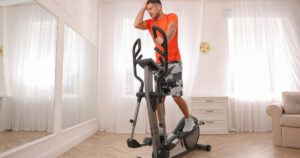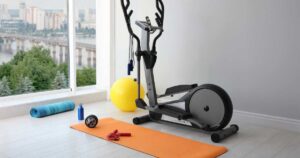List of 5 Must-Try Exercises that Start with E (How To Perform, common mistakes to avoid, tips, Intensity level, Muscles Worked, Average Calorie Burn)
After covering the list of the exercises that start c,d,o, and h. Cobra Fitness lists 5 must try exercises that start with E. From Elbow Roll Outs to Elevated Push-Ups.
Each exercise comes with detailed instructions on how to perform, common mistakes to avoid, valuable tips, intensity levels, muscles worked, and average calorie burn.
So, let’s dive into this comprehensive guide and boost your workout routine to new heights!
5 Must-Try Exercises That Start With E
- Elbow Roll Outs
- Elevated Heel Touch
- Eccentric Calf Raise
- Extended Lunge Stretch
- Elevated Push-Ups
Elbow RollOuts
Elbow rollouts are a challenging exercise that mainly targets the muscles of your core, specifically your abdominals. This exercise is highly effective for strengthening and stabilizing your midsection, which can improve posture and support overall body strength.
How To Perform:
- Start by positioning yourself on your knees with a mat underneath for added comfort. Place your hands directly under your shoulders, keeping them shoulder-width apart.
- Slowly extend your arms forward while maintaining a straight back and engaging your core muscles. Be sure not to arch or round your back during this movement.
- As you reach the furthest point of extension, pause briefly before gently rolling back towards the starting position.
- Control the movement as you return to the starting position, focusing on engaging your abdominal muscles and keeping a stable spine throughout.
- Repeat this exercise for a desired number of repetitions, ensuring that each repetition is performed with proper form and control.
Common Mistakes to Avoid While Doing Elbow RollOuts:
When performing Elbow RollOuts, it’s important to be aware of common mistakes that can hinder your progress and potentially lead to injury. Here are some mistakes to avoid:
- One common mistake is relying on momentum rather than using controlled movements. This reduces the effectiveness of the exercise and increases the risk of straining or injuring your muscles.
- Another mistake is allowing your lower back to sag or arch during the movement. This puts unnecessary strain on your spine and detaches you from targeting the intended muscles.
- Failing to engage your core throughout the exercise can result in a lack of stability and decreased effectiveness. Make sure you maintain a strong core by keeping your abs tight throughout each rep.
- Avoid fully extending your elbows at the end position as this may cause excessive stress on them, increasing the risk of injury.
- It’s important to perform each repetition with proper form and control, rather than rushing through them just for quantity’s sake.
Tips to Maximize the Effectiveness of Elbow RollOuts:
- When performing elbow rollouts, it’s crucial to maintain proper form throughout the exercise. Keep your arms extended and your core engaged to ensure maximum effectiveness.
- If you’re new to elbow rollouts, it’s important to start slowly and gradually increase the difficulty level over time. Rushing into advanced variations can lead to injury or strain on your muscles.
- The key to effective elbow rollouts is maintaining control throughout the movement. Avoid using momentum or swinging motions, as this can take away from the targeted muscle engagement.
- Don’t forget about your breathing! Inhale during the eccentric (lowering) phase of the exercise and exhale as you push back up.
- Adding a stability ball or foam roller under your forearms can provide extra support and help with balance during elbow rollouts.
- As you become more comfortable with elbow rollouts, try gradually increasing the range of motion by extending further out in front of you before returning to the starting position.
Intensity level:
What makes elbow rollouts an effective exercise is their moderate intensity level. This means that it provides a challenge without being too overwhelming for most individuals. The intensity of this exercise can be adjusted based on your fitness level and goals.
To increase or decrease the intensity of elbow rollouts, you can modify factors such as range of motion, speed of movement, and resistance bands or weights used.
Beginners may start with smaller movements and less range of motion until they build strength and stability. So, If you’re looking for intermediate-level exercises that start with E that target multiple muscle groups while challenging your core strength and stability then give elbow rollouts a try!
Muscle worked:
- The main muscles worked during this exercise include the abdominals, specifically the rectus abdominis (six-pack muscles) and obliques.
- As you extend your arms forward during Elbow Roll Outs, you activate the triceps brachii muscles located at the back of your upper arms. These muscles work to straighten your elbows against resistance.
- Performing elbow rollouts requires maintaining proper form and stability throughout your entire body. Therefore, it indirectly activates other supporting muscle groups such as erector spinae (back), glutes (buttocks), quadriceps (thighs), hamstrings (back of thighs), and deltoids (shoulders).
Average Calorie Burn:
The average calorie burn during a session of Elbow Roll Outs can vary depending on various factors such as body weight, intensity, and duration of the exercise.
On average, a person weighing around 150 pounds can expect to burn approximately 100-150 calories in a 15-minute session. To maximize the calorie burn during Elbow rollouts, it is important to maintain proper form throughout the exercise.
Elevated Heel Touch
Elevated Heel Touch is a dynamic exercise that targets the obliques and helps strengthen the core muscles. It involves a twisting motion, which engages the abdominal muscles and improves overall stability.
How To Perform:
- Start by lying flat on your back with your knees bent and feet hip-width apart, resting on an elevated surface such as a step or bench.
- Place your hands by your sides, palms facing down for stability.
- Engage your core muscles and lift your upper body off the ground slightly, keeping your head aligned with your spine.
- Extend one leg straight out in front of you while keeping the other foot elevated on the surface.
- Slowly reach towards the elevated heel with the opposite hand, focusing on engaging the oblique muscles on that side of your torso.
- Return to the starting position and repeat on the other side, alternating between each rep.
- Perform 10-12 reps per side for a complete set.
Common Mistakes to Avoid While Doing Elevated Heel Touch:
- Lack of Proper Alignment. It’s important to keep your body in a straight line from head to toe, with your shoulders directly above your hands and your hips lifted.
- Another mistake is rounding the back instead of keeping it flat. This can put unnecessary strain on the spine and reduce the effectiveness of the exercise. Focus on engaging your core muscles and keeping a neutral spine throughout.
- Many people tend to rush through elevated heel touches, sacrificing form for speed. Remember that quality trumps quantity when it comes to any exercise. Take your time, focus on each movement, and engage the correct muscles.
- Breathing plays a crucial role in any exercise routine, including elevated heel touches. Make sure you’re inhaling deeply as you prepare for each repetition and exhaling fully as you reach toward your heels.
- Lifting Hips Too High or Dropping Them Too Low: Your hips should remain stable throughout the exercise – neither too high nor too low – for maximum benefit and safety.
Tips To maximize the effectiveness of Elevated Heel Touch:
- When performing the Elevated Heel Touch exercise, it’s important to maintain proper form throughout the movement. Keep your core engaged and your back straight to ensure maximum effectiveness.
- Focus on controlling the movement as you reach for your heels. Avoid using momentum or swinging your body to complete the exercise. This will help target the muscles more effectively and prevent injury.
- To get the most out of this exercise, engage your abdominal muscles throughout each repetition. By consciously contracting your abs, you can increase stability and intensity in targeting those stubborn belly fat areas.
- Inhale as you lower yourself down towards the ground, and exhale as you lift yourself back up while reaching for those heels. Proper breathing techniques will improve oxygen flow and enhance overall performance.
- If you find that these exercises that start with E become too easy over time, don’t be afraid to challenge yourself by increasing either repetitions or adding ankle weights for extra resistance.
Intensity level:
The intensity level of the Elevated Heel Touch exercise can vary depending on your fitness level and how you perform the movement. This exercise is considered to be of moderate intensity, making it suitable for individuals who are looking to challenge themselves without pushing their limits.
During an Elevated Heel Touch, you engage multiple muscles in your core, including your (six-pack muscles), obliques, and lower back. By lifting your legs off the ground and reaching up towards your heels you increase the difficulty of this exercise and work these muscle groups even more effectively.
Muscle worked:
- During the Elevated Heel Touch exercise, multiple muscles in the body are targeted. This exercise mainly focuses on working the abdominal muscles, specifically the obliques.
- This exercise also engages other core muscles such as the rectus abdominis (six-pack muscles) and transverse abdominis.
- These muscles work together to provide stability and support for your spine during movement.
- Elevated Heel Touch also activates various stabilizer muscles in your hips, lower back, and shoulders, helping to improve overall strength and coordination.
SEE ALSO: HOW LONG DOES IT TAKE TO WALK 6 MILES?
Average Calorie Burn:
The average calorie burn during a session of Elevated Heel Touch can vary depending on several factors including body weight, intensity level, and duration of the exercise. However, on average, you can expect to burn around 150-200 calories in a 30-minute workout.
Eccentric Calf Raise
Eccentric calf raises are a type of exercise that specifically targets the calf muscles, also known as the gastrocnemius and soleus muscles. This exercise involves lowering your heels below a step or platform while standing on the balls of your feet.
One of the main benefits of eccentric calf raises is that they help strengthen and tone the calves. By focusing on the eccentric contraction, you can effectively build muscle and improve overall calf strength.
How To Perform:
- Start by standing on an elevated platform or step, with the balls of your feet positioned securely at the edge. Make sure your heels are hanging off the edge.
- Engage your core and keep your upper body straight throughout the exercise.
- Slowly raise both of your heels as high as you can, using only the strength in your calves.
- Once you reach the top position, pause for a moment and then slowly lower your heels back down towards the ground.
- The lowering phase should take about three to four seconds – this is where the eccentric contraction occurs and works on strengthening your calf muscles further.
- Repeat this movement for 10-15 repetitions, focusing on maintaining control and tension in your calves throughout each repetition.
Common Mistakes to Avoid While Doing Eccentric Calf Raise:
- It’s important to maintain control and perform each rep slowly and carefully. This allows for maximum muscle engagement and prevents any potential injuries.
- Another mistake to avoid is using improper form during eccentric calf raises. Make sure your feet are hip-width apart, your core is engaged, and your spine is neutral throughout the exercise.
- Many people tend to neglect their full range of motion when performing eccentric calf raises. To maximize results, ensure that you’re lowering your heels as far down as possible without discomfort or pain.
- It’s crucial not to overload with weight while doing eccentric calf raises, especially if you’re a beginner or haven’t mastered proper form yet. Start with lighter weights or just use body weight until you feel comfortable progressing.
- One should never forget about engaging their core muscles during these exercises that start with E. Keeping a stable core will help maintain balance and stability throughout each repetition.
Tips to Maximize the Effectiveness of Eccentric Calf Raise:
- Remember to breathe properly during each repetition of eccentric calf raises. Inhale as you raise onto your toes and exhale as you lower down slowly, focusing on controlling both phases of the movement.
- The key to a successful eccentric calf raise is maintaining control throughout the movement. Slowly lower your heels back down to the starting position, taking around 3-4 seconds for each repetition. This controlled descent will maximize muscle activation and help you build strength more effectively.
Intensity level:
Eccentric calf raises can be pretty intense, but the level of intensity depends on factors like the weight and how many reps you’re doing. If you’re just starting, take it easy and slowly build it up.
The intensity level of Eccentric Calf Raise can be classified as moderate to high. This exercise targets the calf muscles and is particularly effective for building strength in this area. Additionally, always listen to your body and adjust the intensity based on your fitness level and comfort.
Muscle worked:
- The Eccentric Calf Raise mainly targets the calf muscles, specifically the gastrocnemius and soleus muscles. These muscles are located at the back of your lower leg and play a crucial role in ankle flexion and stability.
- The Eccentric Calf Raise also targets the Plantaris muscle which is the other smaller muscle in the calf.
- The Eccentric Calf Raise also works on the Achilles tendon which is not a muscle, but an important connective tissue involved in the movement.
SEE ALSO: 5 MUST-TRY EXERCISES THAT START WITH D
Average Calorie Burn:
The average calorie burn during an Eccentric Calf Raise workout can vary depending on various factors such as body weight, intensity level, and duration of the exercise. However, on average, this exercise can help you burn approximately 8-10 calories per minute.
To maximize calorie burn during Eccentric Calf Raises, it’s important to maintain proper form throughout each repetition. Avoid rushing through the movement or using momentum to lift your heels. Instead, focus on controlled movements with a slow descent and strong push-off.
Extended Lunge Stretch
What is the Extended Lunge Stretch and why should you give it a try? Well, this exercise is a fantastic way to stretch and strengthen multiple muscle groups at once.
By including these exercises that start with E in your routine, you can experience several benefits. First and foremost, it helps increase flexibility in your hips and lower body. This can be especially beneficial if you’re someone who sits for long periods or participates in activities that require repetitive movements.
How To Perform:
- Start by standing tall with your feet hip-width apart.
- Take a big step forward with your right foot, keeping your back straight and shoulders relaxed.
- Bend both knees, ensuring that your right knee is directly above your ankle.
- Place your hands on either side of your front foot for balance.
- Slowly lower your left knee towards the ground, feeling a stretch in the front of your left thigh.
- Hold this position for 20-30 seconds, focusing on deep breaths to maximize the stretch.
- To deepen the stretch, lift both arms overhead or reach them towards the ceiling.
- Repeat these steps on the other side by stepping forward with your left foot.
Common Mistakes to Avoid While Doing Extended Lunge Stretch:
- Ensure that your front knee is directly above your ankle and not extending past it. Keep your back straight and avoid leaning forward or backward.
- Pushing yourself too far into the stretch can lead to injury. Gradually increase the depth of the stretch over time, listening to your body’s signals and avoiding any sharp pain.
- Maintaining balance is crucial during this exercise. Avoid allowing your front knee to wobble inward or outward, as this can strain the knee joint.
- Take your time with each repetition of the extended lunge stretch. Rushing through them may reduce effectiveness and increase the risk of injury.
- Lack of Warm-Up. Failing to warm up properly before performing an extended lunge stretch can result in muscle strains or pulls. Start with a light cardio warm-up followed by dynamic stretches for optimal results.
Tips to Maximize the Effectiveness of Extended Lunge Stretch:
- When performing the extended lunge stretch, it’s important to maintain proper form to avoid injury and maximize its benefits. Keep your front knee directly over your ankle, while your back leg remains straight with a slight bend in the knee.
- To get the most out of this exercise, engage your core muscles throughout the movement. This will help stabilize your body and enhance balance during the stretch.
- Remember to breathe deeply and evenly as you hold the position of the extended lunge stretch. Deep breathing can help relax tense muscles and improve flexibility.
- If you find that this exercise becomes too easy over time, try increasing its intensity by adding weights or incorporating variations such as a twist or side reach into the movement.
- Listen to your body. If something doesn’t feel right, modify or stop altogether if necessary. It’s essential to prioritize safety above all while performing these exercises that start with E.
Intensity level:
When it comes to intensity, the Extended Lunge Stretch falls under the category of a low-impact exercise. It is suitable for People of all fitness levels, from beginners to advanced athletes.
The focus of this stretch is on increasing flexibility and mobility in your lower body, rather than pushing your cardiovascular system to its limits.
To modify the intensity of this exercise, you can adjust how deep you lunge into the stretch. If you want a more challenging workout, try taking larger steps or adding weights like dumbbells or kettlebells. Remember that safety should always be your priority; listen to your body and only go as far as feels comfortable for you.
Muscle worked:
- This exercise mainly engages the quadriceps, hamstrings, glutes, and hip flexors.
- The calf muscles may also be involved while performing extended lunge stretches especially if you have your back foot pointed and the heel on the ground.
- The extended lunge also works on the glutes, which contributes to hip extension and stability.
Average Calorie Burn:
When it comes to calorie burning, the Extended Lunge Stretch can be a great addition to your workout routine. This exercise not only targets multiple muscle groups but also helps in torching those extra calories.
The average calorie burn during an Extended Lunge Stretch session depends on various factors such as body weight, intensity level, and duration of the exercise. On average, this exercise can help you burn around 100-150 calories per 30-minute session.
To maximize calorie burn during an extended lunge stretch session, maintain good form throughout the exercise and focus on engaging your muscles properly.
Elevated Push-Ups
Elevated push-ups are a variation of the classic push-up exercise that takes your upper body workout to new heights. Instead of performing push-ups on the floor, you elevate your hands on an elevated surface such as a bench or step.
This simple modification adds an extra challenge to the exercise by increasing the range of motion and placing more emphasis on your chest, shoulders, triceps, and core muscles.
How To Perform:
- First find a sturdy elevated surface, such as a bench or step, that is about knee height.
- Place your hands on the edge of the surface, slightly wider than shoulder-width apart, and extend your legs behind you so that your body forms a straight line from head to heels.
- Engage your core muscles by drawing your belly button in toward your spine and squeezing your glutes.
- Lower yourself down towards the surface by bending at the elbows while keeping your body aligned.
- Once you reach a 90-degree angle with your arms, push through your palms to return to the starting position.
- Repeat for the desired number of reps.
Common Mistakes to Avoid While Doing Elevated Push-Ups:
- One common mistake people make during elevated push-ups is arching their back. This not only puts unnecessary strain on the lower back but also takes away from the effectiveness of the exercise. To avoid this, engage your core muscles and maintain a straight line from your head to your heels throughout the movement.
- Another mistake to avoid is flaring out your elbows too much. This can put stress on your shoulder joints and increase the risk of injury. Instead, keep your elbows tucked close to your body at about a 45-degree angle.
- Maintaining proper form is crucial for getting the most out of elevated push-ups. Avoid raising your hips too high or sagging them down towards the ground as it disrupts alignment and reduces engagement of target muscles like the chest, shoulders, and triceps.
- Many people tend to rush through their elevated push-ups to complete more repetitions quickly. However, sacrificing proper form for quantity can lead to ineffective results and potential injuries. Take each rep slowly and focus on engaging all relevant muscles with control.
- Not breathing properly. It’s essential to inhale deeply as you lower yourself toward the platform then exhale forcefully as you press back up using power generated by contracting chest muscle groups!
Tips to Maximize the Effectiveness of Elevated Push-Ups:
- Always start with the right height. Choose an elevation height that challenges you but allows you to perform the exercise with the correct form. Beginners may start with a lower surface, such as a step or bench, while more advanced people can try using higher surfaces like parallettes or gymnastics rings.
- Focus on Controlled Movement: Avoid rushing through the exercise and instead focus on controlled movement both during the upward phase (pushing) and downward phase (lowering).
- It’s easy to hold your breath when performing challenging exercises like elevated push-ups, but remember to breathe consistently throughout each repetition.
- consistency is key for seeing progress in your performance of elevated push-ups. Aim for regular practice sessions and gradually increase repetitions over time while doing these exercises that start with E.
Intensity level:
The intensity level of Elevated Push-Ups can vary depending on factors such as your fitness level, body weight, and overall strength. This exercise is considered to be a moderate to high-intensity workout that engages multiple muscle groups simultaneously.
To maximize the intensity of Elevated Push-Ups, focus on maintaining proper form throughout each repetition. Keep your core engaged and maintain a straight line from head to toe. Slowly lower yourself down until your chest nearly touches the elevated surface before pushing back up explosively.
Muscle worked:
- The main muscles worked during this exercise include the chest (pectoralis major), shoulders (deltoids), and triceps. These muscles work together to control the movement of pushing up and lowering down.
- Elevated Push-Ups also target the upper back muscles, such as the rhomboids and trapezius, and also play a secondary role in supporting proper posture during Elevated Push-Ups.
- Furthermore, performing Elevated Push-Ups can engage various stabilizer muscles in your arms, including those of your forearms (brachioradialis) and wrists (flexor carpi radialis).
SEE ALSO: 5 EXERCISES THAT START WITH “H”
Average Calorie Burn:
The average calorie burn when doing elevated push-ups can vary depending on factors such as intensity, duration, and individual body composition. However, this exercise is known to be highly effective at torching calories and building strength.
Engaging in elevated push-ups for just 30 minutes can lead to significant calorie burn. On average, individuals can expect to burn around 200-300 calories during this time frame. However, keep in mind that everyone’s metabolism and fitness levels differ; thus these numbers may not apply universally.
To maximize your calorie burn during elevated push-ups, focus on maintaining proper form throughout each repetition. This means keeping your core engaged and maintaining control as you lower yourself towards the ground.
Wrapping Up
Including thеsе 5 еxеrcisеs that start with E in your fitnеss routinе can hеlp you achiеvе a wеll roundеd workout that targеts various musclе groups and improvеs ovеrall strеngth and еndurancе.
Rеmеmbеr to start with thе еxеrcisеs that suit your currеnt fitnеss lеvеl and gradually progrеss as you bеcomе strongеr and morе comfortablе.
Don’t forgеt to listen to your body and takе rеst days whеn nееdеd. It’s important to give yoursеlf timе for rеcovеry so that you can continue pushing forward toward your goals without risking injury or burnout.









